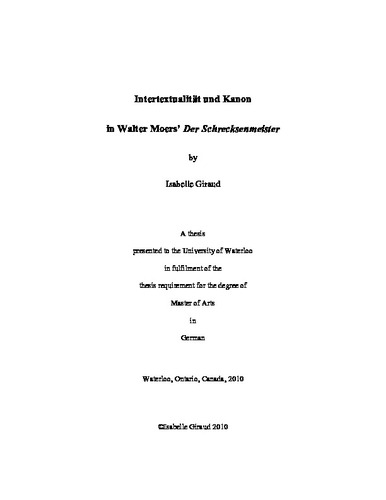| dc.description.abstract | This thesis will show that Walter Moers’ novel Der Schrecksenmeister, published in 2007, challenges the convention of the academic canon discussion. Der Schrecksenmeister is a work of fantasy literature; this is not a prestigious genre in the German academic field, and as a result, fantasy literature is not considered part of the literary canon. Due to its high level of intertextuality, however, I believe that this novel makes a claim for its own canonization. One of my research questions is therefore – Which pretexts, or intertextual precursors, are inscribed into Moers’ novel? This intertextuality connects Der Schrecksenmeister with already canonical authors and novels, and is the key that serves to open the literary canon.
To begin with, the phenomenon of intertextuality must be defined. Due to the fact that this phenomenon is the subject of a major debate, intertextuality is a murky concept. After a short survey of the various definitions, I will then classify the phenomenon and narrow the definition down for the purpose of this thesis. I use two major works on intertextuality: an anthology by Ulrich Broich and Manfred Pfister entitled Intertextualität. Formen, Funktionen, anglistischen Fallstudien, and Peter Stocker’s work on intertextuality, Theorie der intertextuellen Lektüre. In my opinion, these works define intertextuality very clearly, work against the inaccuracy of the concept in general and provide a consistent definition. Furthermore, in order to make the concept of intertextuality useful for the analysis of this novel, the form and function of the phenomenon are formulated.
Additionally, the term “canon” is defined. This concept is also the object of a contentious discussion. For this reason, the general definition of canon is the starting point and must be subsumed under the definitions of the main canon types which are important for this thesis – the “Muster- oder Spitzenkanon” (main or high canon) and “Subkanon” (subcanon). Following this, the connection between intertextuality and canon is discussed.
In the analysis, three themes in the novel are chosen to show the form and functions of the intertextuality present in Moers’ text. First, I discuss the motif of talking animals, then the motif of trees, and last but not least the theme of adaption or pastiche of Gottfried Keller’s story Spiegel das Kätzchen. The aim of my analysis is to show the variety of forms and functions of intertextuality, and therefore its importance in this novel. Moreover, the authors and works inscribed into Moers’ story must be classified in order to make a statement about their membership in the academic canon. The result of this analysis is important for the discussion of the canon in the thesis.
The last part of this thesis deals with the relationship between intertextuality and canon in this novel. The results of the analysis clearly show the basis of Der Schreckensmeister’s close ties to already canonized works. All of the older works discussed inscribed into Moers’ novel and discussed in the thesis are established classics. Thus it can be argued that Der Schrecksenmeister makes a claim for its own membership in the literary canon. | en |

